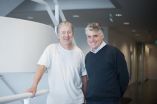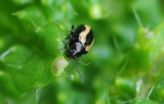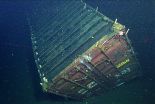(Press-News.org) University of Adelaide research may help in the fight against terrorism with the creation of a sensor that can detect tiny quantities of explosives with the use of light and special glass fibres.
Published in the journal Sensors and Actuators B: Chemical, the researchers describe a novel optical fibre sensor which can detect explosives in concentrations as low as 6.3 ppm (parts per million). It requires an analysis time of only a few minutes.
"Traditionally explosives detection has involved looking for metals that encase them such as in land mines," says project leader Dr Georgios Tsiminis, from the University's Institute for Photonics and Advanced Sensing.
"In today's world, however, homemade improvised explosive devices will often have no metal in them so we need to be able to detect the explosive material itself. This can be difficult as they often don't interact with chemicals and we don't want them near electricity in case they explode."
Instead, the researchers are using a plastic material which emits red light when illuminated with green laser light – and the amount of red light it emits is reduced by the presence of explosives.
Three minute holes at the core of specially manufactured optical fibres are coated with the plastic or polymer material in a thin layer. The explosives sample is drawn up the holes in the fibre by capillary action and the amount of red light emitted measured.
"This has high sensitivity and we can detect tiny quantities of an explosive in a small sample," says Dr Tsiminis, who is an Australian Research Council Super Science Fellow. "And not only do we know if explosives are there, we can quantify the amount of explosive by looking at how the light emission changes over time."
Dr Tsiminis says the sensor is ideal for forensics investigations to determine whether explosives have been present in a particular location. It's inexpensive, quick and easy to use and could be done on site to detect trace amounts of explosive.
"What I like about this technology is that it has a lot of complicated physics underlying it, but it is really a very simple concept," Dr Tsiminis says.
"It also requires very little explosives present so is very sensitive. So forensic investigators would be able to take swabs from various surfaces, place them in some organic solvent and, within a few minutes, know if there have been explosives present."
INFORMATION:
The research was done in collaboration with the Defence Science and Technology Organisation.
Media Contact:
Dr Georgios Tsiminis
ARC Super Science Fellow
Institute for Photonics & Advanced Sensing
The University of Adelaide
Phone: +61 8 8313 2330
Mobile: +61 (0)428 223 627
georgios.tsiminis@adelaide.edu.au
Robyn Mills
Media and Communications Officer
The University of Adelaide
Phone: +61 8 8313 6341
Mobile: +61 410 689 084
robyn.mills@adelaide.edu.au
Detecting trace amounts of explosives with light
2014-05-08
ELSE PRESS RELEASES FROM THIS DATE:
'Parent' cells reset the cell division clock
2014-05-08
Melbourne researchers have overturned a 40-year-old theory on when and how cells divide, showing that 'parent' cells program a cell division time for their offspring that is different from their own.
Scientists from the Walter and Eliza Hall Institute have shown that both phases of the cell cycle contribute to the overall change in division time rather than one staying fixed in duration as previously thought. They have developed these findings into a new model that helps scientists predict how a population of cells has divided.
Their research could impact our understanding ...
Low-carbohydrate diet reduced inflammation
2014-05-08
A low-carbohydrate diet, but not a low-fat diet, reduces inflammation in patients with type 2 diabetes, according to research at Linköping University in Sweden.
It is known that patients with type 2 diabetes have higher levels of inflammation than those who do not have the disease, and it is believed that this may contribute to a higher risk of cardiovascular disease and other complications. In a clinical trial at Linköping University a low-carbohydrate diet was compared with a traditional low-fat diet in 61 patients with type 2 diabetes. Only patients in the low-carbohydrate ...
Public perceive alcohol adverts breach regulatory code, research finds
2014-05-08
A majority of the UK general public perceive alcohol adverts to breach the Advertising Standards Authority's Broadcast Committee of Advertising Practice (BCAP) Code suggesting that the current regulatory system for UK television is inadequate, research from The University of Manchester shows.
Researchers surveyed 373 adults, aged 18-74 years, showing them one of seven adverts that had been broadcast in the previous month on leading commercial television channels.
Overall 75 per cent of the participants rated the adverts as breaching at least one rule from the BCAP Code ...
Beetles that taste like mustard
2014-05-08
Almost all herbivorous insects are specialized to feed on specific host plants and have adapted to their chemical defenses. Flea beetles are important pests of cabbage and other cruciferous plants, such as mustard, horseradish and rapeseed. These plants use a sophisticated defense system, known as the mustard oil bomb, to get rid of their enemies : If plant tissues are wounded, glucosinolates and an enzyme known as myrosinase come into contact, and, as a result, toxic metabolites are formed which deter most insects. This defensive mechanism, however, has no negative effect ...
Pesticides: Research provides new insights into their effects on shrimps and snails
2014-05-08
Ground breaking research by an international team of scientists has resulted in greater understanding of the effects of pesticides on aquatic invertebrates such as shrimps and snails.
Research published in the journal Environmental Science & Technology by a team of scientists from the UK, Switzerland and Finland provides an important new approach for systematically measuring and modelling the sensitivity of aquatic invertebrates to various pesticides.
Aquatic invertebrate species are abundant in European freshwaters and play an important role in the decomposition of organic ...
Luminescent nanocrystal tags enable rapid detection of multiple pathogens in a single test
2014-05-08
WEST LAFAYETTE, Ind. — A research team using tunable luminescent nanocrystals as tags to advance medical and security imaging have successfully applied them to high-speed scanning technology and detected multiple viruses within minutes.
The research, led by Macquarie University in Sydney, Australia and Purdue University, builds on the team's earlier success in developing a way to control the length of time light from a luminescent nanocrystal lingers, which introduced the dimension of time in addition to color and brightness in optical detection technology.
Detection ...
Cedars-Sinai study: Common drug restores blood flow in deadly form of muscular dystrophy
2014-05-08
LOS ANGELES (May 7, 2014) – Cedars-Sinai Heart Institute researchers have found that a commonly prescribed drug restores blood flow to oxygen-starved muscles of boys with Duchenne muscular dystrophy, a genetic muscle-wasting disease that rarely is seen in girls but affects one in 3,500 male babies, profoundly shortening life expectancy. It is the most common fatal disease that affects children.
Muscle weakness begins in early childhood, often causing deformity of the arms, legs and spine. Heart and respiratory muscles often begin to fail before children reach early teen ...
New study sheds light on survivors of the Black Death
2014-05-08
A new study suggests that people who survived the medieval mass-killing plague known as the Black Death lived significantly longer and were healthier than people who lived before the epidemic struck in 1347.
Caused by the bacteria Yersinia pestis, the Black Death wiped out 30 percent of Europeans and nearly half of Londoners during its initial four-year wave from 1347 – 1351.
Released Wednesday (May 7) in the journal PLOS ONE, the study by University of South Carolina anthropologist Sharon DeWitte provides the first look at how the plague, called bubonic plague today, ...
New care approach eases depression among women
2014-05-08
Women who received collaborative care for depression at an obstetrics and gynecology clinic showed fewer symptoms after treatment than women receiving usual depression care in the same setting, recent University of Washington research found.
The collaborative approach comprises counseling and greater patient engagement than is typical of mental health care at specialty clinics. It involves psychiatrists, clinicians, specialists and depression care managers. The team meets weekly to review patient progress and provide treatment recommendations. The care manager follows ...
First-ever study describes deep-sea animal communities around a sunken shipping container
2014-05-08
MOSS LANDING, CA — Thousands of shipping containers are lost from cargo vessels each year. Many of these containers eventually sink to the deep seafloor. In 2004, scientists at the Monterey Bay Aquarium Research Institute (MBARI) discovered a lost shipping container almost 1,300 meters (4,200 feet) below the surface of the Monterey Bay National Marine Sanctuary. In the first-ever survey of its kind, researchers from MBARI and the sanctuary recently described how deep-sea animal communities on and around the container differed from those in surrounding areas.
In February ...



